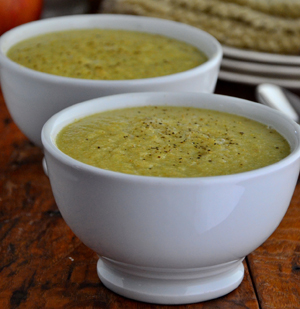Apple Soup—Better than Snert!
Friday, 10 January 2014 17:43
 Most every restaurant will offer soup, but not every “restoring shop” will have a uniquely delicious apple soup. Says this expert, they should.
Most every restaurant will offer soup, but not every “restoring shop” will have a uniquely delicious apple soup. Says this expert, they should.
By Wendy Brannen
Did you know that restaurants and soup are synonymous? According to my favorite modern source—Wikipedia—the word restaurant, or “something restoring,” was first used in France in the 16th century to refer to a highly concentrated, inexpensive soup sold by street vendors and purported to be an antidote to physical exhaustion. In 1765, a Parisian entrepreneur opened a shop specializing in these soups, which prompted the use of the modern word restaurant.
Their histories intertwined, it seems no mistake that one is hard pressed to find a decent restaurant that does not serve soup in some form—piping hot or chilled, clear bouillon or thick bisque, vegan or loaded with savory chunks of meat. The preparation and serving choices are as diverse as, well, alphabet soup, as are the regional varieties of this comforting staple, which range from “she-crab” in the Carolina Low Country to something called “snert” served with a sausage over in the Netherlands.
So, if you are a chef seeking your own twist on a signature soup, where do you start? Might I suggest at the beginning of that alphabet soup of options? And, “A is for apple,” after all!

 Videos by Ted Russin are included in a free course with 80,000 students worldwide.
Videos by Ted Russin are included in a free course with 80,000 students worldwide. A Q&A with Gavin Kaysen, who while young represented the United States in the Bocuse d’Or and today heads the kitchen of Café Boulud in New York City.
A Q&A with Gavin Kaysen, who while young represented the United States in the Bocuse d’Or and today heads the kitchen of Café Boulud in New York City. One of the most powerful techniques to help students remember what they have learned and apply it to a range of situations is the assignment to write letters to themselves.
One of the most powerful techniques to help students remember what they have learned and apply it to a range of situations is the assignment to write letters to themselves. Delivering cooking demonstrations to the public and select groups not only benefits others by sharing your and your students’ expertise and talent. More importantly, it also builds and promotes your program’s unique brand. And the strongest advice from Chef Weiner? Keep it simple.
Delivering cooking demonstrations to the public and select groups not only benefits others by sharing your and your students’ expertise and talent. More importantly, it also builds and promotes your program’s unique brand. And the strongest advice from Chef Weiner? Keep it simple.